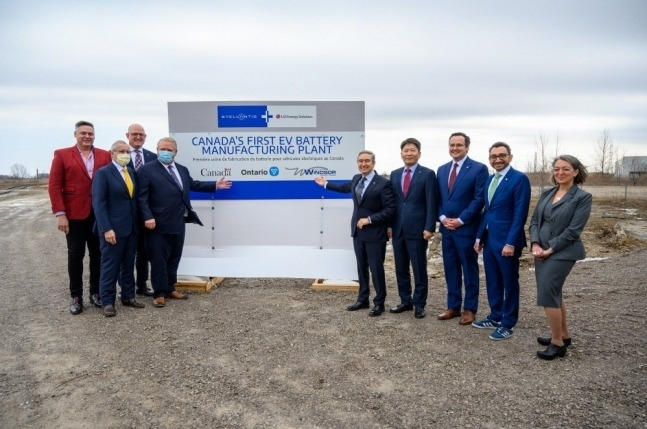LG Energy Solution, Stellantis, Canadian gov’t agree on subsidies for battery plant
Suspended construction work on joint battery plant to resume immediately
By Byun Hye-jinPublished : July 6, 2023 - 15:32

LG Energy Solution said Thursday it has come to an agreement with the Canadian government on the conditions of subsidies for the construction of a joint battery plant for electric vehicles with Stellantis.
Nextstar Energy, a joint venture between LG Energy Solution and Stellantis, signed the final contract for the battery production plant in the Canadian province of Ontario. Meanwhile, the federal and local governments agreed to offer subsidies equivalent to those provided under the US’ Inflation Reduction Act, according to the Korean battery maker.
The “equivalent subsidies” means an advanced manufacturing production credit, or AMPC, offered to locally produced battery cells and modules, worth $35 and $10 per kilowatt hour, respectively.
Even though the company declined to disclose the exact amount of subsidies, a source close to the matter said, “The subsidies could reach roughly 14 to 15 trillion won (about $11 billion).”
The source added that the amount appears larger than that offered to Volkswagen, calling it a feat for the LG-Stellantis joint venture. The Canadian government is said to have offered more than 13 billion Canadian dollars ($9.7 billion) in subsidies for the German carmaker’s planned battery plant in Ontario and an additional grant of CA$700 million.
Following the latest agreement, LG Energy Solution and Stellantis also agreed to resume construction of the battery plant immediately. Construction has been halted for almost two months due to a dispute between the federal and provincial governments regarding the subsidies.
Scheduled to start operation next year, the plant’s annual production capacity is 45 GWh. Located in Windsor, Ontario, the newly built plant is expected to create approximately 2,500 jobs for the Canadian economy.
“We are glad to resume construction of our new plant (with Stellantis), which will become a key production base for EVs and battery markets in North America,” Kim Dong-myeong, president of the advanced automotive battery division at LG Energy Solution in a statement.
Kim added the company is grateful to both the Korean and Canadian governments for making efforts to seek a breakthrough in the stalled talks.
Later in the day, Seoul’s presidential office also welcomed the agreement, touting it as the outcome of diplomatic efforts between the two governments.
Expectations were high for the summit between President Yoon Suk Yeol and Canadian Prime Minister Justin Trudeau held in Seoul on May 16 as the high-level meeting came a day after LG and Stellantis suspended construction work on the battery plant.
During his three-day visit, the Canadian leader also reportedly met with LG’s top executives, possibly to discuss the plant issue.
At the time, Francois-Philippe Champagne, Canada’s minister of innovation, science and industry also hinted that the Canadian government was eager to offer subsidies on par with those pledged earlier to Volkswagen.
Mark Stewart, chief operating officer for North America at Stellantis, also expressed gratitude and said, “The IRA has completely reshaped the battery production ecosystem in North America. It has become challenging to manufacture quality batteries without the support from the (Canadian) government similar to the US.”




![[KH Explains] No more 'Michael' at Kakao Games](http://res.heraldm.com/phpwas/restmb_idxmake.php?idx=644&simg=/content/image/2024/04/28/20240428050183_0.jpg&u=20240428180321)






![[Grace Kao] Hybe vs. Ador: Inspiration, imitation and plagiarism](http://res.heraldm.com/phpwas/restmb_idxmake.php?idx=644&simg=/content/image/2024/04/28/20240428050220_0.jpg&u=)







